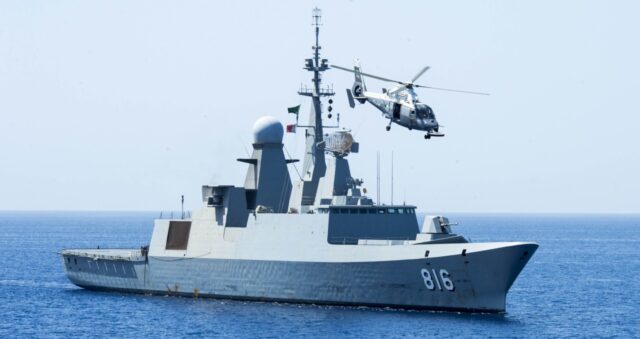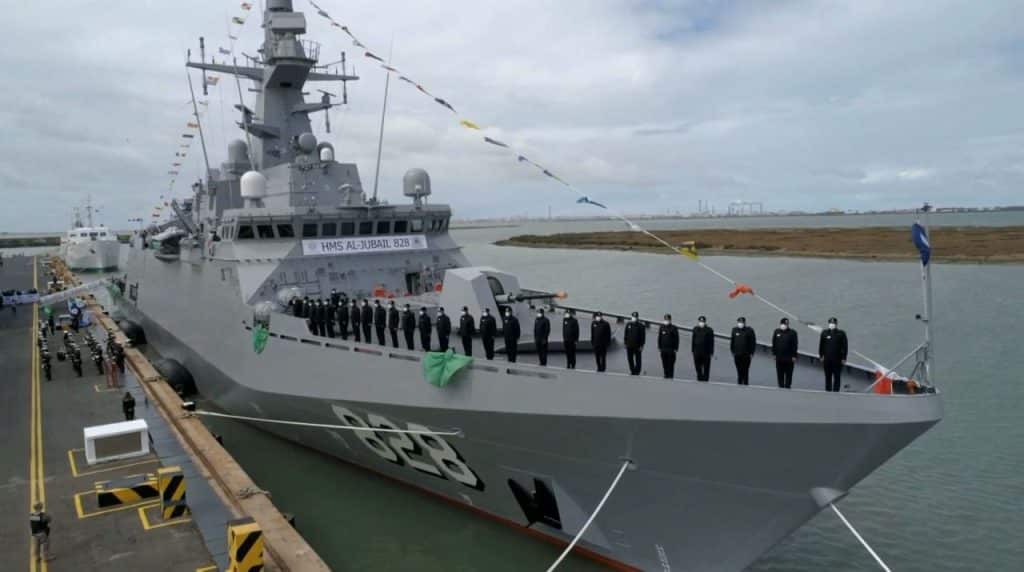The Kingdom of Saudi Arabia is not slowing down the modernization of its fleet to prepare it for a possible confrontation with Iran. The purchase of ships in Spain is part of an extensive modernization program in the face of regional tensions and a potential new nuclear deal with Iran. The navy has grown into one of Riyadh’s priorities. Of greatest importance to the success of the Saudi plan is a quintet of new Avante 2200 multi-role corvettes, which were ordered back in 2018.
The production of this series is a joint project of Saudi Military Industries Company (SAMI) and the Spanish Navantia shipyard. The first of the five vessels classified locally as Sarawat – Al-Jubayl – on August 25 arrived at the Al-Malik Faisal naval base in Jeddah and will operate on the Red Sea. The delivery schedule assumes that all ships will be in service by the end of 2024. The last corvette was launched in December 2021, and on July 26, the second representative of the series: Ad-Diriyya, was formally handed over.
-ADVERTISEMENT-
Al-Jubayl is a 104 meters long and 14 meters wide ship operated by a 102-person crew. It is to develop a maximum speed of 27 knots, and its autonomy will be 21 days. The armament consists of two 324 mm three-tube torpedo tubes, a six-chamber vertical launcher for RIM-162 ESSM anti-aircraft missiles, two quadruple RGM-84 Harpoon anti-ship missile launchers, a sea gun Leonardo OTO Melara Super Rapid caliber 76 mm and large-caliber machine gun positions. In addition, the ship was equipped with the Rheinmetall Air Defense Oerlikon Millennium direct defense system with a 35-millimeter revolver cannon. At the stern there will be a hangar with a landing pad for the MH-60R Seahawk helicopter.
The Corvettes will be equipped with the Catiz combat system, the Dorna artillery fire control system, the Navcom / Hermesys integrated communication system, the Minerva navigation system and the Complex-Simplex integrated management system. Navantia adapted the ship to the needs and requirements of the Saudi navy by installing additional combat systems and making them resistant to extreme temperatures.
The agreement with Navantia awakens Riyadh’s hopes for a technology transfer that will help achieve the Saudi Vision 2030, an ambitious set of economic goals set by Prince Muhammad ibn Salman. Part of this transfer has already contributed to the creation of Saudi Arabia’s first Hazem naval system, combining a combat management system, an integrated communications system, an integrated ship management system, a fire control system, and a training system.
In addition to the Sarawat series, Riyadh will introduce four Multi-Mission Surface Combatant (MMSC) frigates into service with the Eastern Fleet. They will be derivatives of the American Freedom LCS, and their area of operation will be the waters of the Persian Gulf.

USS Billings (LCS 15) of Freedom class.
(US Navy / Lockheed Martin)
“Saudi Arabia is strengthening its fleet with frigates, armed motor boats and patrol vessels as part of its multi-annual naval development program,” said Corrado Cok, defense expert at Gulf State Analytics think tank. – These marine resources increase Saudi Arabia’s ability to monitor and patrol the waters surrounding the country and counter asymmetric attacks by allies of Tehran or the Iranian navy.
Sarawat Corvettes are to join the fleet of Western Saudi Arabia, which means that they will not sail in the Persian Gulf, where Iran’s activity is the highest. Instead, they will be given another important task: to protect some 1,800 kilometers of Saudi Red Sea shores and to secure shipping in the Gulf of Aden, directly outside Yemen, where Iranian Houthi proxy forces are stationed.
Saudi Arabia currently operates three French-modified La Fayette-type Ar-Riyadh multi-role frigates built by DCNS and commissioned in 2002. Although older, these frigates are capable of operating in ocean waters and played a key role in the operations against Ansar Allah in 2015 during Operation Decisive Storm.
Dangerously in the Red Sea and the Persian Gulf
The last two weeks have seen increased tensions in the waters of the Middle East. The operations of the navy of the Islamic Revolutionary Guard Corps in the Persian Gulf have gained particular significance. The two attempts to steal unmanned sea vehicles from under the nose of the Americans showed that Iran’s announcements of building a fleet for an asymmetric war are not words thrown to the wind.
On August 29, the ships of the 5th Fleet spotted the auxiliary ship Shahid Bazjar in the international waters of the Persian Gulf towing the American unmanned intelligence vessel Saildrone Explorer. Thanks to the quick response of the USS Thunderbolt (PC 12) patrol vessel, the ship was recovered. After initial doubts, it turned out that the Pasdarani knew perfectly well the value of Saildrone Explorer for Americans.
*** BREAKING *** # Iran’s IRGC attempted to take a US Navy Saildrone Explorer uncrewed surface vessel (USV)
US Navy patrol boat, USS Thunderbolt (PC 12), intervened. Tow released.
Nod @ryankakiuchan pic.twitter.com/lrDdZ6RWLj
– HI Sutton (@CovertShores) August 30, 2022
On August 30, while patrolling the Gulf of Oman, a US patrol boat intercepted a fishing vessel smuggling drugs worth an estimated $ 20 million. A few days later, the Iranian sailors repeated the operation to hijack the sea drones. This time, two of the same type were “secured” by the crew of another Iranian ship – the Jamaran frigate of the Muja-class – in the waters of the Red Sea. They were covered with tarpaulins and initially pretended that nothing had happened. Once again, however, the Iranians yielded to American calls to return the drones.
The Saudis want to counteract attacks by both Houthis on commercial and civilian humanitarian ships and by Somalis involved in piracy, human trafficking, and arms and drug smuggling. They also want to cut off the cooperation of Somali fighters from Ansar Allah in the transport of African mercenaries to the fighting in Yemen. Threats from the sea are not as advanced as those from the air due to ballistic missiles and circulating ammunition, but the Saudis must not underestimate them.
Defense against threats from the sea would become more important in a confrontation with Iran. Then the ships of the Iranian Navy or Pasdatans (or cooperating Shiite militias) could launch ballistic or maneuvering missiles and ammunition also circulating from the waters of the Persian Gulf. At present, however, the smuggling of weapons to Yemen via sea routes through the Red Sea and the Gulf of Aden remains a major threat.
China will enter the game?
The modernization of the Saudi navy – in particular, the desire to rapidly procure ships and weapons systems – could open the way for the People’s Republic of China to join in. However, is it possible to strengthen defense relations between Beijing and Riyadh? Last month, there was a lot of speculation about a possible visit by Xi Jinping to the Arabian Peninsula.

Saudi frigate Ad-Dammam (816) of the Ar-Riyadh type with the Dauphin helicopter.
(US Navy / Mass Communication Specialist Seaman Jesse A. Hyatt)
“China’s arms sales to the Middle East were in narrow areas, but not in maritime technology,” said Jon Alterman, director of the Middle East at the Center for Strategic and International Studies. While I wouldn’t be surprised if Saudi Arabia sourced some niche products from China, I would be very surprised to see Riyadh turning away from relying on Western training and logistics systems.
What’s up on the other side of the Persian Gulf? In recent days, Tehran informed about the commissioning of the catamaran Shahid Soleimani (FS313-01). It was named after the Iranian general Ghasem Soleimani, who died at the hands of the Americans in Baghdad in January 2020.
THREAD: Shahid Soleimani-class catamaran warship pic.twitter.com/pjP41QAn4h
– Aᴍɪʀ (@AmirIGM) September 5, 2022
At the ship’s handover ceremony in Bandar-e Abbas, Iranian Armed Forces Chief of Staff General Mohammad Bagheri announced that the line now includes the first nationally developed ship equipped with short- and medium-range vertical missile launchers. Six maneuvering missiles are placed in the launchers on the sides of the deck, and the crew has a 30mm cannon and four 20mm cannons at their disposal. At the stern, the ship is equipped with a helicopter deck, under which there is a hangar for a small motorboat. At the same time, two missile boats were commissioned: Shahid Dara (P313-6) of the Tondal type (commissioned after renovation and limited modernization) and Shahid Rouhi (P313-11).
By accepting Shahid Soleimani into service, Iran announces that it will continue to focus on building a less technically advanced fleet, but capable of asymmetric operations. Another vessel – quite well armed for Iranian conditions – will have at its disposal fast motor boats used by the Pasdranos in the tactic of swarming and harassing larger enemy ships without the possibility of causing more harm to them. Tehran gives a sign that operations such as the one of April 2, 2021, when three Pasdaran motor boats and the Shahid Nazeri catamaran harassed a pair of American coast guard patrols for over three hours, will be their main weapons not only against Saudi Arabia, but also against the United States and Israel.
See also: TikTok in the hands of soldiers threatens US national security
Navantia

